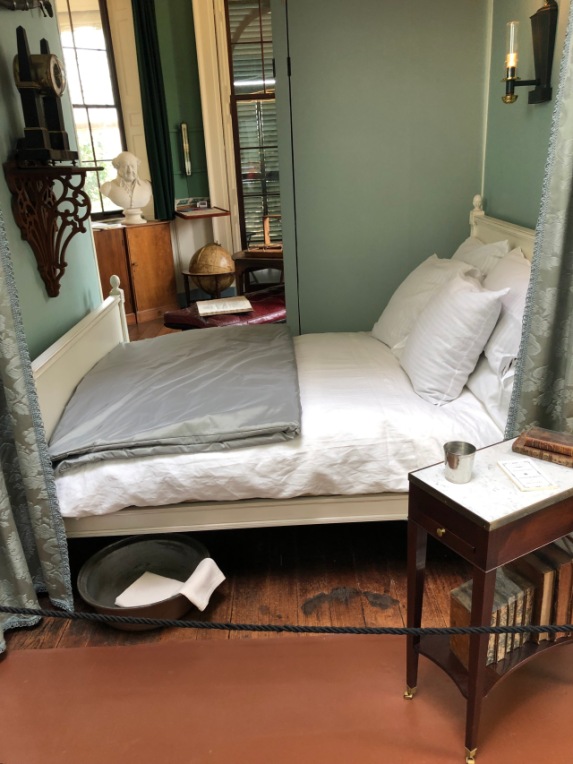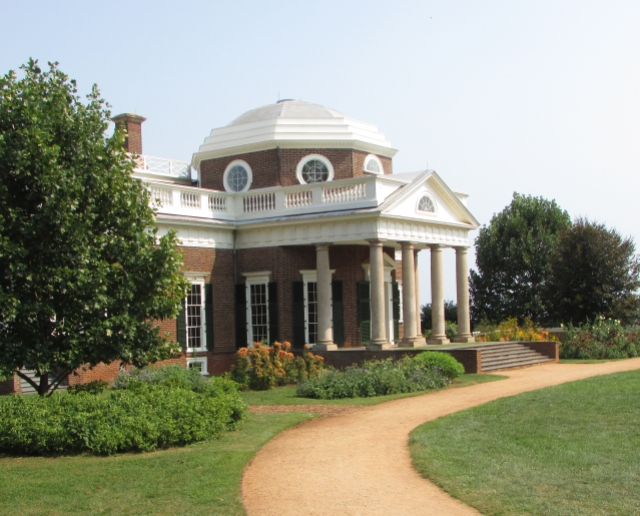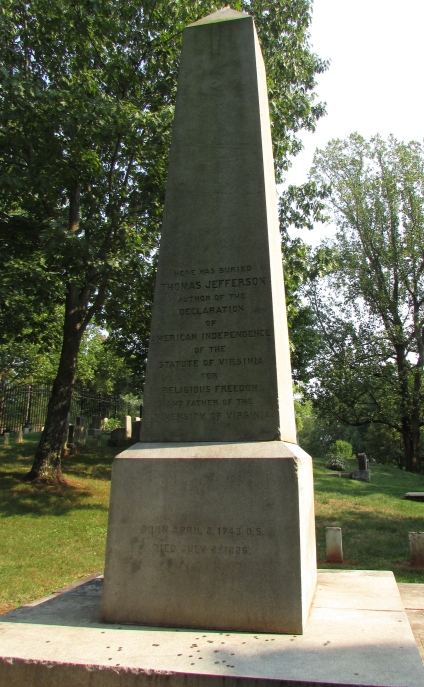
The home of Thomas Jefferson, Monticello sits atop a hill on some of the 5,000 acres of land that he inherited from his father. Begun in 1768, it took Jefferson forty years to complete the house. This was partially due to his love of architecture and partially due to the fact that family members moved in and needed space. Our tour guide told us that Mr. Jefferson’s sister moved in with her eleven children during the years in which he was supposed to be enjoying retirement.

About 60 percent of the current contents of the home did belong to Jefferson, though some items have been lost, are in other museums, or in the hands of private collectors. We saw several of his inventions, including a two-sided clock that can be seen inside the house and above the door on the porch, a dumbwaiter hidden in the side of the dining room fireplace that goes to the wine cellar, and a contraption which held a second pen and copied everything as he wrote.
The property, along with the University of Virginia, is a UNESCO World Heritage Site. The university, which is just a few miles from Monticello, was established by Jefferson who also designed the original buildings. Construction began on the most famous building, The Rotunda, in 1822, and was completed just after Jefferson’s death in 1826.




Monticello was also home to more than 100 enslaved laborers, including Jefferson’s half sister-in-law, Sally Hemings. It is now known that Jefferson fathered at least six of Hemings children, four of whom lived to adulthood. The story of Sally Hemings is fascinating, though little is known about her – not even what she looked like or where she is buried. What is known about her is detailed on the Monticello website here: https://www.monticello.org/sallyhemings/. There are also Amazon Video and Netflix documentaries about her and her ancestors for those who want to learn more. Notably, James Hemings, Sally’s older brother, was Jefferson’s chef at Monticello. James went to Paris with Jefferson while he was serving as Minister to France. James was trained in French cooking there and became a master chef. Sally arrived in Paris two years later while serving as Jefferson’s daughter’s companion and maid. Interestingly, slavery had been outlawed by then in France so legally James and Sally were free while they lived there.

Mulberry Row, a community in itself, is where the laborers lived and worked at Monticello. Here the excavated remains of homes and several shops, such as ones where carpentry and blacksmithing among other crafts and trades took place, can be seen today. The lush flower and vegetable gardens that were once tended by enslaved people are still grown at Monticello along Mulberry Row. For more information on Mulberry Row click here: https://www.monticello.org/slavery/landscape-of-slavery-mulberry-row-at-monticello/.
Jefferson was penniless when he died on July 4, 1826. His heirs were tasked with selling off acreage, possessions (sadly this included slaves who were said to have represented 90 percent of his property) and eventually the grand house to pay the debts. Monticello passed through several owners before being purchased by the Thomas Jefferson Foundation in 1923.
Past Mulberry Row is a path that leads to Monticello’s cemetery where Thomas and Martha Jefferson are buried along with many members of their family. Though no known African-Americans are buried in the family cemetery at Monticello, archaeologists discovered an unmarked Jefferson-era slave cemetery in 2001. This discovery was important because it is known that 400 – 600 enslaved people worked and lived at Monticello, and until the cemetery was found nobody knew where they had been buried.

We could go on for days about what we learned at Monticello, however, we have to end somewhere. In closing, we leave you with these final tidbits:
*Monticello had up to five bathrooms (privies), or air closets as Jefferson referred to them on his blueprints for the home. Historians know that the house did not have flush toilets, but not much else is known about the workings of them.
*Though Jefferson was representing the government as the Minister to France, all expenses involved with living and entertaining there were out of his own pocket.
*The Hemings family were inherited by Thomas and Martha Jefferson upon the death of Mrs. Jefferson’s (and Sally Hemings’) father, John Wayles.
*Sally Hemings quarters were discovered and excavated in 2017 then restored and opened to the public in 2018.
*Jefferson was only thirty-three-years-old when he was asked to write the Declaration of Independence. It only took seventeen days for him to compose the document and two days for the Second Continental Congress to make changes and declare independence on July 4, 1776. We never knew that any government got things done that quickly!
Finally, we highly recommend clicking on https://www.monticello.org/ to learn about the third President of the United States and his beloved home.
Thank you for hanging with us through this long post. We hope you will join us again soon for another great road trip. Until next time…
Travel safe, travel smart, and we will see you down the road!
Mike and Kellye

As always, we strive to be as accurate with our information as possible. If we made a mistake, it was unintentional. (Hey, we’re only human!) We aren’t paid for our recommendations, and we only recommend our own tried and true vendors and venues. Our suggestions are for places that we’ve heard good things about but haven’t visited personally, and our opinions are our own.
©2021
